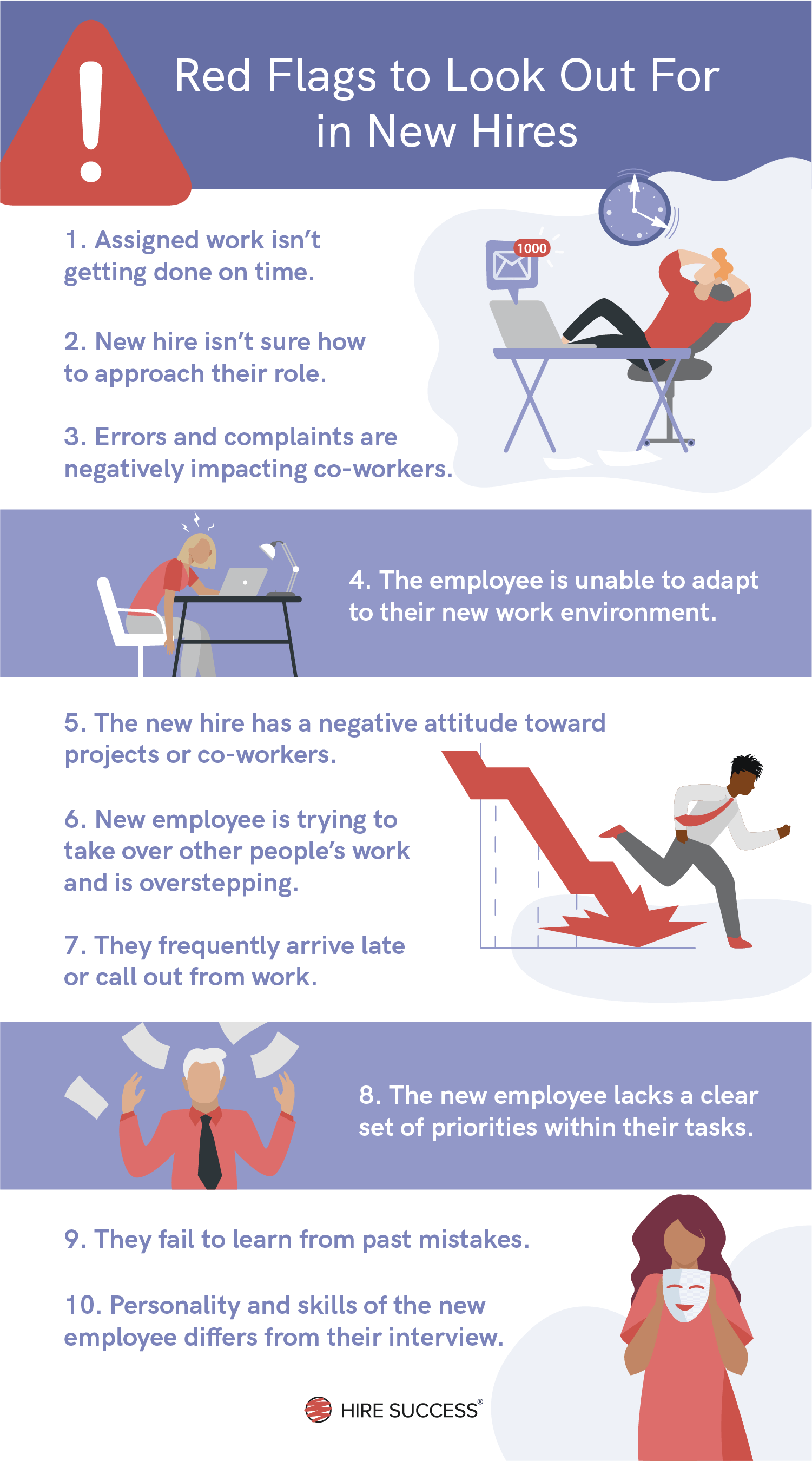Not every new hire is a top-performer and not every bad hire is a catastrophe. However, hiring mistakes are always costly. The productivity of your team is at stake. The sooner you can replace a bad hire, the better.
Red flags aren’t always obvious. Spot small issues before they become big problems. Weed out toxicity before it can poison your team, tarnish your company culture, or negatively affect your public image.
Here’s how to spot new employee red flags and what to do next.
10 signs of a bad hire

Bad hires come in different varieties. Some misrepresent their skills and turn out to be incompetent. Some can’t handle the pressure. Some need constant attention. Lastly, some are unable to learn new skills or respond to developing situations. The worst bad hires drag the entire team down with negative behavior. Any of these bad hires cost your business. Here are the warning signs of a bad hire.
1. Assigned work isn’t getting done on time.
If a new employee continuously struggles to meet deadlines and keep up with their workload, they likely aren’t fit for the position. This can be hard to spot, because a good team will pitch in and help out.
Other employees picking up the slack for an underperforming team member mean less work being done overall, and over time, resentment builds. If a new employee can’t keep up after a reasonable training period, you need to find someone who can.
2. New hire isn’t sure how to approach their role.
It may take a while for a new hire to get up to speed, but if they’re confused by their role or rely too heavily on others for support, they may be doing more harm than good. Effective employees know what needs to be done and work proactively. If your new hire is well-trained and still doesn’t seem to understand their responsibilities, they might never be able to move forward.
3. Errors and complaints are negatively impacting co-workers.
Be it from co-workers, managers or clients, more complaints are just one of the impacts of a bad hire. Bear in mind, this can be subtle. These may originate with the new employee seeding discontent, target a supervisor or coworker who has been there for years without prior complaints or be the direct result of the bad hire’s inappropriate behavior.
4. The employee is unable to adapt to their new work environment.
Change is inevitable, especially today. You’ll adopt new software, try new approaches, and introduce radical ideas like replacing donuts with fruit in the break room. It helps when employees embrace change. Inflexible and unadaptable new employees can hold you back. The old way is rarely better.
5. The new hire has a negative attitude toward projects or co-workers.
Even if their technical skills are impressive, a rude employee should be approached before your company culture is negatively affected. Bad attitudes tend to spread until everyone feels angry and upset. Everybody has an occasional bad day, but it takes a special kind of person to consistently spread it.
6. New employee is trying to take over other people’s work and is overstepping.
Some people think getting ahead requires stepping on coworkers or asserting dominance. When a new employee is trying to take over, he may think he’s showing initiative or leadership, but what he’s really doing is being disrespectful and upsetting the rest of the staff.
7. They frequently arrive late or call out from work.
Regardless of the position, reliability is key. Employees who consistently show up late or call out may not value their new job. As a result, they could end up putting your company’s performance at risk.
Occasional lateness or requests for days off is normal. A pattern of behavior, especially from a new employee, is a clear warning sign. Before taking action, find out why. Do they have a conflict that can be resolved with a minor scheduling change? Find out if you’re dealing with disrespect or something personal, such as an ill child or family member.
Say goodbye to guesswork, hire with confidence
Try our platform for free and get unbiased, data-driven insights into candidates' personal qualities and abilities.
Book a Demo Try It Free8. The new employee lacks a clear set of priorities within their tasks.
Many jobs entail balancing several different tasks. If a new employee is unable to effectively prioritize them, they may not be an ideal match for the position. This may be related to several things: not understanding the job, poor decision-making skills or reluctance to do certain tasks. Any reason, though, impacts productivity. If it can’t be fixed with a conversation, you may have to take action.
9. They fail to learn from past mistakes.
Everyone makes mistakes, but not everyone learns. If you’re stuck correcting the same mistakes time and time again, there’s a good chance you made a hiring mistake. Good employees won’t make the same mistake again.
10. Personality and skills of the new employee differs from their interview.
Interviews can be inadequate evaluation tools. You think you’re making a connection on a personal level, but your questions failed to reveal the candidate’s true personality. It’s a persona. Effective job interview questions can greatly improve your chances of hiring the right person. Without testing, that’s your best and maybe only way of asserting judgment. Personality doesn’t always jump off a résumé. For whatever reason, that can be a clear warning sign of a bad hire if a candidate isn’t what you expected.
How much time does a new employee need to adjust to their job?
Most new employees need three to six months to fully settle into their role. If a new hire takes longer, it’s important to root out the reason. You either have a bad hiring process, a bad onboarding process, or both. It’s up to you to figure out what’s going wrong.
How to know if you’ve made a bad hire or if your hiring process needs improvement?
Examine the result of your recent hires. If their performance is disappointing or you have hired more than one who underperformed, quit or had to be fired, your process is probably the problem.
Was the hiring process and onboarding consistent and comprehensive?
Your hiring and onboarding process should be consistent and tailored to the position you’re trying to fill. If you’re hiring based on a set of questions you downloaded from the web or making decisions based on gut feelings, your process needs improvement. If you pick employees with great experience and they struggle to perform, you may need a procedural change.
Does the new employee have all the skills and aptitude required?
Unless you’re administering skills and aptitude testing, you only have the candidate’s word. Being familiar with a task is much different than being good at it. Before you hire a big talker with mediocre skills, find out what they can do.
Is their job description clear and comprehensive of all responsibilities?
Understanding baselines for each position will help you define an effective job description. This will attract the right kind of candidates. When you start with higher-quality candidates, you have a much better chance of hiring a productive employee.
Does the new hire receive an adequate level of support from their supervisor and co-workers?
New hires are not always welcome additions. Before you decide the new employee is at fault, interview other employees and observe team dynamics. Look for conflicting instructions from employees who have different approaches to the same job.
For a new employee, this can be unsettling and counter-productive. Body language is a giveaway. If a supervisor claims their door is always open, but the open door is accompanied by clear signs of impatience or annoyance, new hires learn quickly to avoid asking for help.
Was the new employee hired at the right time?
Timing is important. If a desk was vacated and the rest of the staff absorbed the extra work, the position might be unnecessary. New employees who don’t have enough work may either be unnecessary or available to take on additional responsibilities. Consider expanding job responsibilities to include more challenging work.
What to do when you’ve identified a bad hire
So you’ve identified a potential problem. Maybe it’s an employee who inconsistently underperforms after six months on the job. They’re missing deadlines, their work is sloppy, and other employees are complaining. What’s next? Should you just tell them it’s not working out and start the whole process over? Not always. There are some things you can try first.
Help your new employee to improve in their position
Before taking any negative actions, try to figure out why the new employee is not catching on. It could be a bad hire. It could also be a training issue, poor skills in one area, vaguely defined responsibilities, or some other easy-to-fix problem. The hiring process is expensive. You don’t want to start that over unless you must.
First, directly address the problem. Ask questions, give constructive feedback, and offer possible solutions. Suppose your new hire is a hands-on learner, and your software training is strictly visual. Poor productivity could be solved with plenty of practice.
You may also face sensitive cultural issues. In today’s global workplace, your employees may be struggling to understand tasks in a second language, or discreetly trying to balance religious requirements, health needs, or responsibilities at home. We can find space for prayer, meditation, or breast feeding a few times a day without embarrassing people in the process.
Another common issue is personality type. If you didn’t understand the job requirements and hired an introverted, detail-oriented person to do a job usually done by an outgoing, big-picture personality type, that’s not a good fit. The answer may be to move your introvert internally to a department like data analysis or accounts payable.
How to prevent future issues with new hires
The best way to avoid bad hires and prevent future problems is with a proven hiring process that includes effective job descriptions, testing, and personality evaluation. If it sounds like a complicated process, it is. It’s also necessary. You don’t need to do it alone. Use a professional hiring system to cut your business costs.
Hire Success® can help you use data to improve hiring. It offers various features that work to streamline and add certainty to the process. Hire Success®’ applicant tracking system narrows your search down to a shortlist of candidates suited to the open position. From pre-employment personality tests to a lightweight applicant tracking system, you’ll not only speed up and focus your hiring campaigns, but also enjoy making the best decisions for your business.


